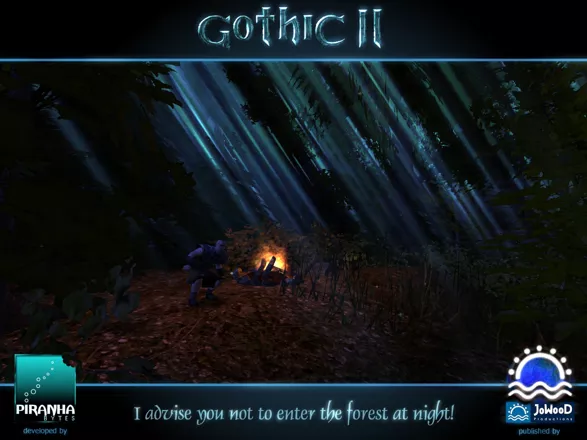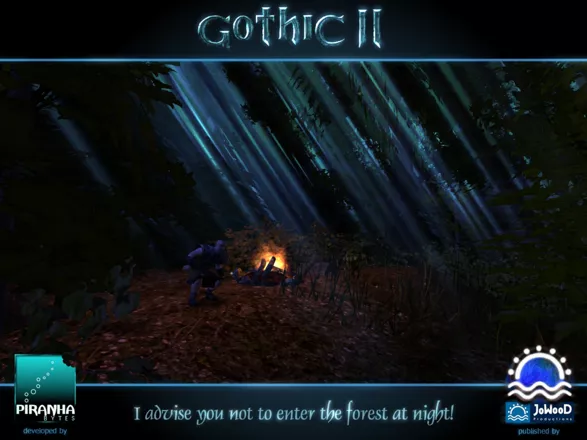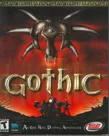Gothic II: Night of the Raven
Description official descriptions
Night of the Raven is the official add-on to Gothic II. The add-on introduces a new playable area called Jharkendar, a previously inaccessible part of the base game's island, separated from the rest of it by mountains. The area has different zones and includes, among others, a deserted city, a canyon, a swamp, as well as several camps and temples. The expansion adds a few new skills (including Acrobatics and the ability to read an ancient language) and new items, as well as a new faction (pirates) and other material that provides more insight into the world of Gothic II as well as its predecessor.
Following community requests, the add-on also increases the difficulty level of the base game, adding tougher monsters, reducing the amount of healing items, and making skills more expensive to acquire.
Groups +
Screenshots
Promos
Credits (Windows version)
87 People (84 developers, 3 thanks) · View all
| Project Manager | |
| Lead Game Design | |
| Project Supervisor | |
| Managing Director | |
| Lead Programmer | |
| Original Game Engine | |
| Engine Extensions | |
| Additional Engine Programming | |
| Tool Programming | |
| Lead Artist | |
| 3D Artists | |
| World Design | |
| [ full credits ] | |
Reviews
Critics
Average score: 86% (based on 13 ratings)
Players
Average score: 4.1 out of 5 (based on 41 ratings with 1 reviews)
Gothic 2 isn't complete without NotR
The Good
NotR isn't an ordinary expansion - it's an add-in whereas most expansions are add-ons. Unlike other expansions, this one puts most of it new content in the early part of the game (the first two chapters, though some have reported completing the expansion part in chapter 4), with small additional tweaks distributed throughout the game.
Most importantly, NotR took the high road of expansion making, and decided to make it more story driven than just an extra challenge for hardcore players (though there is that, too). Anyone who played the first Gothic and the original Gothic 2 would have some questions regarding the game world: What really happened to most people I met, befriended and fought with in Gothic 1? Where did the Water Mages go after the barrier came down? What are the ancient ruins that are scattered about the landscape? Why are the bandits so well stocked in Gothic 2? NotR exists to answer all those questions. NotR tries to tie lose ends to both make the game more complete and to make it an easier setting for a sequel (a sequel that should have never been made, but I digress). Almost immediately after beginning Gothic 2 with NotR you get to meet one of your former prison buddies that lets you know that there is more to the Water Mages than meets the eye, and sets you on your course to help defeat the bandit menace and untangle the mysteries of the island of Khorinis - eventually discovering a hidden land and the ruins of a long lost culture.
While the story does its best to tie both the bandit quest line and the story of the new land, gameplay-wise they are quite distinct and I'll discuss them one at a time:
The first major new quest, to discover who is supplying the bandits a refreshing reshaping of the old and familiar part of the island. This quest and all of its sub-quests takes place almost exclusively in the main part of Khorinis and is a series of many very challenging fights against the various bandit hideouts. If in the original Gothic 2 you could have tried to avoid most bandits in chapter one, this time you are actively encouraged to push yourself to the limit early on, fighting vastly superior foes, but you still can complete the mission without fighting the most fearsome bandits right away or wait for chapter 2 to finish your job. Aside from completing the major quest, you now have several sub-quests of finding missing townsfolk that the bandits carried away (why? you'll find that out eventually). But because this Gothic two of those sub-quests have unexpected solutions and you might find an unlikely ally to help you destroy the strongest of the bandit nests. Call me easily impressed, but I was very excited when I found that in NotR bandits have different loot than they used to have - weapons supplied by the traitor you need to find and gold lumps that can't be obtained anywhere on the main part of Khorinis. It isn't much, but it's the little things that build immersion - new things that tell you that the Nameless Foe No.23 you just killed isn't a simple obstacle, but part of a larger picture that you are about to discover.
The second major quest will take you to a new land - with its own inhabitants, its own factions, its own history, terrain, secrets and monsters - and in a different chapter, with your character stronger and already on the path of his specialization. The land is quite large, about as big as the prison colony, but is so wonderfully diverse and vibrant that the actual prison colony in chapter 3 is seen as a monotonous boring wasteland. The mountainous part is littered with hidden passageways, caves and several layers for you to search in. On the other hand the marshlands appear to be straightforward, but the boggy landscape uses lighting and foliage to hide undead monstrosities and swamp golems. Not content with those two settings, the new land has a massive array of crumbling temples and cave galleries for good claustrophobic exploration. This is also the place where NotR's story is finally told and you find your ultimate reward - a weapon than is useful to any class and scales with you in power. Here you will test your might and magic against an equal mix of non-human and humanoid monsters, giving you a very balanced combat experience. Sadly, saying anything else would just spoil the experience.
Story aside, how about the gameplay? This is perhaps the most controversial part of NotR since they decided to make the game harder - pleasing Gothic fans, but alienating newcomers who have already found the original game too hard. Most of the changes regard the skill point system of Gothic, as well as availability and power of skill-raising potions. In NotR the amount of skill points you pay for any skill, spell, attribute or recipe is directly proportionate to the power of the desired knowledge. In this way weak early skills (like removing bloodflies' wings or the most basic potions and simplest spells) cost even less than in the original Gothic 2, but if you pursue deeper knowledge the cost will rise and rise until it will be double or triple the skill point cost in the original. However, to compensate for that NotR scattered over forty stone tablets (that act just like stat potions) in every part of the world - be it in mainland Khorinis, the prison colony of the new land of Jharkendar. This serves both to reward explorers as well as entice less reckless heroes to look into every nook and cranny to find the much needed tablets.
Lastly, NotR is well aware of the Achilles heel of the entire Gothic series, namely magic. Everyone who ever chose the magician path knows that magics is near to useless at the early to mid game, but suddenly becomes overpowered in the late game when you get hold of one kill-everything-on-screen spell. To mediate this mages in NotR have access to Water magics (non-mages can buy or find some Water scrolls to use) that serve as a good middle ground between the puny early spells and the game-breaking late spells. The new spells - especially Ice Lance and Geyser - provide good damage for low cost. Additionally, the ultimate artifact of NotR provides relatively better spells at lower levels for almost no cost, making a very nice addition to any mage.
The Bad
As an expansion NotR suffers from all the problems of the original game (a quick recap: only one difficulty level - set to hard, slow increase in power, almost exclusively keyboard-based controls and rather useless mages - especially if you take into account that non-mages can cast the same spells from scrolls) but to its credit it does try to fix some problems, unfortunately it ends up making other problems worse.
Perhaps the most common criticism of Gothic games is that their skill point system (combined with how little skill point you can get) make the game almost impossible for anyone who hadn't already completed (or at got far enough into the game) it. The nerfing of potions, the increase in the cost of high skill stages and the fact that you need to wait until chapter 2 to use the new tablets, and even then only if you spent additional points on learning the required language (there are three languages to learn, each harder that the previous!) makes the expansion very unfriendly to people who haven't finished the original game. Essentially, a player must plan from day one the exact amount of training they'll get in what skills in what stage to get optimal results. Otherwise you'll end up with a character that is jack of all trades and can't muster enough strength to pickup a good bow or punch through an orc's armor with a sword. This is not game breaking since shooting from ledges, using scrolls, hit-and-run tactics and such can help you push through even the most difficult parts of the game, but it does make the game frustrating if your paladin lives in crippling fear of a pack of goblins.
Another low point in the game appears in the quest to find the bandit supplier. It doesn't take a genius to identify the guilty party the moment you lay your eyes on him, thus ruining the entire murder mystery atmosphere of the quest. Nevertheless, it doesn't ruin the quest itself since you'll new and interesting people while you do it, but it's somewhat offsetting when a major twist is so clumsily revealed.
I said that I liked how NotR is weaved into the existing world, instead of being attached to its outer layer like a parasite. Unfortunately this forces the player to restart the game entirely instead of continuing playing with their champion. But even if you don't want to play as an unbeatable juggernaut, it's still isn't advisable to locate your expansion in the first two chapters which are already the longest in the game. After finishing the expansion part every other chapter will look disappointingly small and empty. It would have been much better had the expansion part was scaled in difficulty and inserted into the the third to fifth chapters that are badly in need of some more color.
Finally, a word must be said about the new monsters. While they may look new (and some don't even look new - they're just repaints of another monster or taken from Gothic 1), their AI is the same as that of similar creatures you've already fought. For instance, giant praying mantises act as remodeled cavecrawlers and new magical constructs are simply your regular golems. Probably the only new monster are exploding bloodflies, found in the swamps of Jharkendar, because they force melee characters (and pretty much everyone is still a melee character in chapter 2) to be slightly more careful, but even that doesn't account for much.
The Bottom Line
If you enjoyed Gothic 2, you must get this expansion. If you enjoyed Gothic 1 get this expansion with Gothic 2 in a gold edition. This expansion is such an essential part of Gothic 2 that it's hard to see how Gothic 2 can exist without it.
Windows · by Alex Z (1856) · 2012
Analytics
Related Sites +
-
Gothic II Night of the Raven Solution
by Lu Richardson
Identifiers +
Contribute
Are you familiar with this game? Help document and preserve this entry in video game history! If your contribution is approved, you will earn points and be credited as a contributor.
Contributors to this Entry
Game added by Ramon Cahenzli.
Additional contributors: Jeanne, JRK, Xoleras, elfbs.
Game added October 21st, 2003. Last modified January 19th, 2024.






















